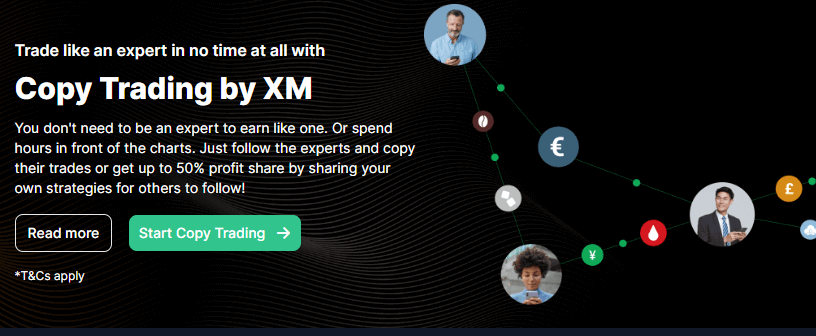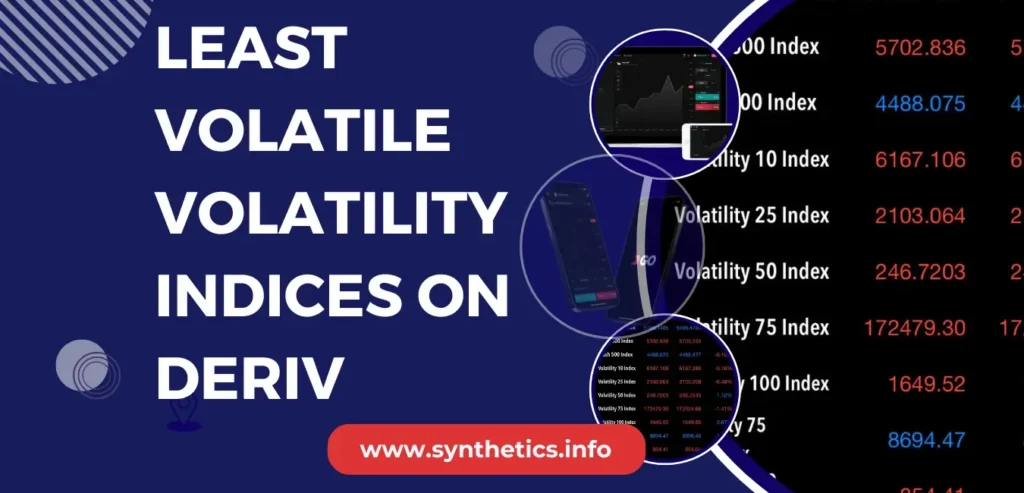Not every trading session calls for chasing wild spikes. Sometimes the goal is precision, consistency, or simply keeping your head clear — and that’s where the least volatile Volatility Indices on Deriv shine.
When I’m testing a new strategy, building up a small account, or trading at odd hours, I often dial it down and focus on these calmer markets. They move with enough rhythm to generate good setups — but without the heart-stopping swings you’ll find on V100 (1s) or V75 (1s).
In this post, I’ll share the 10 least volatile Volatility Indices on Deriv right now — based on fresh data covering the last six months. We’ll look at:
✅ How I ranked them (not guesswork — real numbers)
✅ A clear At a Glance list you can trade from
✅ Practical tips for approaching each index
👉 Important: This post focuses only on Volatility Indices — if you want a broader list that also includes Boom & Crash, Step, and Range Break indices, check out my full guide on
🐌 Least Volatile Synthetic Indices on Deriv.
Ready? Let’s explore the smoothest volatility markets you can trade on Deriv.

How I Ranked the Least Volatile Volatility Indices On Deriv
I didn’t pick these volatility indices by gut feel or forum chatter — I ran the numbers.
Here’s exactly how I ranked them:
1️⃣ Six months of raw data
I pulled M1 (1-minute) candles for every Volatility Index on Deriv — both normal and (1s) versions — from November 1, 2024 to May 22, 2025.
2️⃣ 30-minute range analysis
I resampled that data into 30-minute bars and calculated the high-low range for each bar — the core measure of how much an index typically moves in a half-hour window.
3️⃣ Real USD conversion
I converted those point ranges into actual USD swings based on each index’s minimum lot size — so we’re comparing apples to apples, not just raw point movement.
4️⃣ Ranking by median USD swing
I then ranked all the Volatility Indices by their median 30-minute USD swing — not the average, so big outlier spikes didn’t skew the results. The indices with the lowest median swings are the calmest overall.
👉 The result is a clean, data-driven list of the 10 least volatile Volatility Indices on Deriv you can trade today — no guesswork required.
 Read Review
OPEN AN ACCOUNT
Read Review
OPEN AN ACCOUNT
Min Deposit: USD 1
Total Pairs: 100+
Regulators: MFSA, LFSA, VFSC, BVIFSC
At a Glance — 10 Least Volatile Volatility Indices on Deriv
| Rank | Symbol | Median 30-min USD Swing |
|---|---|---|
| 1️⃣ | Volatility 50 Index (Normal) | $0.1065 |
| 2️⃣ | Volatility 25 Index (Normal) | $0.5562 |
| 3️⃣ | Volatility 10 Index (Normal) | $0.5774 |
| 4️⃣ | Volatility 15 (1s) Index | $0.7098 |
| 5️⃣ | Volatility 30 (1s) Index | $0.7672 |
| 6️⃣ | Volatility 75 Index (Normal) | $1.578 |
| 7️⃣ | Volatility 150 (1s) Index | $3.503 |
| 8️⃣ | Volatility 75 (1s) Index | $6.1338 |
| 9️⃣ | Volatility 10 (1s) Index | $8.05 |
| 10️⃣ | Volatility 100 (1s) Index | $9.9025 |
👉 Note: Some indices (like V75 or V10) appear near the middle of both my Most Volatile and Least Volatile lists — volatility is a continuum, not an on/off switch. This list shows which Volatility Indices have the lowest median USD swing over the past six months — ideal for calmer, more controlled trading.
Breakdown By Symbol
Let’s go in-depth on each less volatile volatility index and show it’s characteristics.
Volatility 50 Index (Normal) — The smoothest Volatility Index for testing setups
Median 30-min USD swing: $0.1065
Smallest USD swing: $0.0146
Largest USD swing: $0.1985
Median range: 266.3 pts
Min lot size: 4
Best time to trade it: Moves steadily across all sessions; no strong time bias.
How I trade it:
👉 EMA Bounce (M15)
Plot 8 and 21 EMAs — enter first close back to aligned EMAs in trend direction.
👉 Pullback to 50 EMA (H1 → M30)
Confirm H1 trend with 50/200 EMAs. Wait for pullback to 50 EMA, take first M30 bar.
👉 Box Breakout (M5)
Draw box around last 5 bars — trade breakout with 2-bar confirmation.
Perfect for:
✅ Beginners
✅ Small accounts
✅ Strategy testing

Volatility 25 Index (Normal) — Calm trending index with occasional bursts
Median 30-min USD swing: $0.5562
Smallest USD swing: $0.1285
Largest USD swing: $0.984
Median range: 1 112.45 pts
Min lot size: 0.5
Best time: Tends to trend cleanly during London and late US session (15:00–20:00 GMT+2).
How I trade it:
👉 EMA Pullback (M15)
Trade first pullback to 8/21 EMA zone in direction of H1 trend.
👉 Breakout-Retest (M5)
Box last 10 candles — wait for breakout and retest, then enter.
👉 ATR Pullback Fade (M30)
Fade 1.5× ATR pullbacks after strong run.
Works for:
✅ Beginners
✅ Calm trading
✅ Building consistency
Volatility 10 Index (Normal) — The slowest-moving of the “core 10” volatility indices
Median 30-min USD swing: $0.5774
Smallest USD swing: $0.1464
Largest USD swing: $1.0085
Median range: 1 154.85 pts
Min lot size: 0.5
Ideal time: Moves slowly but cleanly throughout all sessions; ideal for testing.
How I trade it:
👉 EMA Crossover Entry (M15)
Trade first bar after EMA 8/21 crossover in trend direction.
👉 Range Breakout (M5)
Box last 5–10 candles — trade breakout.
👉 50 EMA Bounce (H1)
Classic pullback to 50 EMA on H1 chart, ride small trend legs.
Who it’s good for:
✅ Beginners
✅ Very small accounts
✅ Strategy sandbox

Volatility 15 (1s) Index — Smooth and balanced 1s volatility index
Median 30-min USD swing: $0.7098
Smallest USD swing: $0.1548
Largest USD swing: $1.2647
Median range: 3 548.9 pts
Min lot size: 0.2
Optimal times: Best during 08:00–12:00 GMT+2 and 18:00–21:00 GMT+2.
How I trade it:
👉 M1 EMA Scalper
EMA 8/21, trade first close beyond high/low of last 3 bars.
👉 Donchian Breakout (M5)
20-period Donchian — trade breakout on momentum.
👉 Trend Pullback (M15)
Trade first pullback after H1 50/200 EMA crossover.
Fits:
✅ Calm scalping
✅ Small accounts
✅ Progressing from V10/V25
Volatility 30 (1s) Index — Steady trending with small swings
Median 30-min USD swing: $0.7672
Smallest USD swing: $0.1876
Largest USD swing: $1.3469
Median range: 3 836.25 pts
Min lot size: 0.2
When to trade it: Best during 09:00–11:00 GMT+2 and 18:00–20:00 GMT+2.
How I trade it:
👉 M5 Box Breakout
Box last 10 bars, trade breakout with 2-bar confirmation.
👉 EMA Trend Rider (M15 → M5)
Confirm H1 trend, enter M5 EMA bounce.
👉 Counter-ATR Fade (M15)
Fade 1.5× ATR runs back to mean.
Works for:
✅ Beginners scaling up
✅ Small accounts
✅ Smooth scalping

Volatility 75 Index (Normal) — Classic high-reward index with low baseline volatility
Median 30-min USD swing: $1.578
Smallest USD swing: $0.2871
Largest USD swing: $2.8688
Median range: 157 796 pts
Min lot size: 0.001
Time to trade it: Spikes during 10:00–11:00 GMT+2 and 20:00–23:00 GMT+2.
How I trade it:
👉 Trend Pullback (H1 → M30)
Wait for pullback to H1 50 EMA, enter M30 continuation.
👉 M5 EMA Scalper
EMA 5/13 scalping pattern on momentum runs.
👉 Counter-Swing Fade (M30)
Fade extreme M30 candles >3× ATR.
Who it’s perfect for:
✅ Traders progressing to faster markets
✅ Building confidence before V75 (1s)
Volatility 150 (1s) Index — Medium-paced 1s index, good for learning fast trading
Median 30-min USD swing: $3.503
Smallest USD swing: $0.36
Largest USD swing: $6.646
Median range: 3 503 pts
Min lot size: 0.1
Best time chunk: Best during 09:00–11:00 GMT+2 and 18:00–20:00 GMT+2.
How I trade it:
👉 EMA Trend Pullback (M5 → M1)
Confirm trend on M5 → scalp on M1 EMA pullbacks.
👉 Donchian Channel Breakout (M5)
Trade confirmed breakouts from consolidation.
👉 Counter-ATR Fade (M15)
Fade overextended 1.5–2× ATR moves.
Who it’s meant for:
✅ Small accounts
✅ Learning 1s dynamics
✅ Testing breakout systems

Volatility 75 (1s) Index — Iconic fast-paced index with high risk-reward
Median 30-min USD swing: $6.1338
Smallest USD swing: $1.0925
Largest USD swing: $11.175
Median range: 12 267.5 pts
Min lot size: 0.05
When to attack it: Peaks around 10:00–11:00 GMT+2 and 20:00–23:00 GMT+2.
How I trade it:
👉 Trend Pullback (H1 → M5)
Classic pullback to H1 trend with M5 entry.
👉 M1 EMA Scalper
EMA 8/21 pattern for ultra-tight scalps.
👉 Breakout Fade (M15)
Fade extreme breakouts on high volatility days.
Who it’s good for:
✅ Advanced beginners
✅ Small aggressive accounts
✅ Building toward larger V75 1s strategy
Volatility 10 (1s) Index — Smooth intro to 1s scalping
Median 30-min USD swing: $8.05
Smallest USD swing: $1.96
Largest USD swing: $14.14
Median range: 1 610 pts
Min lot size: 0.5
When to trade it: Moves steadily — best during 08:00–12:00 GMT+2 and 18:00–21:00 GMT+2.
How I trade it:
👉 M1 EMA Scalper
Classic EMA 8/21 scalping system — easy to learn on this index.
👉 Breakout-Retest (M5)
Box 5 bars, trade confirmed retests.
👉 Counter-ATR Fade (M15)
Fade extended moves — low risk due to index behavior.
Who it’s ideal for:
✅ Beginners moving into 1s indices
✅ Strategy testing
✅ Small accounts

Volatility 100 (1s) Index — High-volatility scalping playground
Median 30-min USD swing: $9.9025
Smallest USD swing: $1.61
Largest USD swing: $18.195
Median range: 1 980.5 pts
Min lot size: 0.5
When to push it: Spikes during 04:00–06:00, 11:00–12:00, and 20:00–21:00 GMT+2.
How I trade it:
👉 M1 EMA Scalper
EMA 8/21, classic fast scalping — tight stop, fast exits.
👉 Breakout Snapback (M5)
Fade fast 2× ATR breakouts on 5 min chart.
👉 Trend Pullback (H1 → M5)
Catch trend continuations after H1 pullbacks.
Who it’s suitable for:
✅ Advanced beginners
✅ Learning fast execution
✅ High-focus scalping

Why Trade Less Volatile Volatility Indices On Deriv?
If you’re looking for smoother, more forgiving markets on Deriv — the top 5 least volatile Volatility Indices offer the perfect place to start.
Indices like V50 (Normal), V25 (Normal), V10 (Normal), V15 (1s), and V30 (1s) move with far less aggression than their faster cousins. This makes them ideal for:
✅ Testing new strategies — controlled swings help you evaluate entry/exit logic without massive drawdowns
✅ Building small accounts — slower markets mean tighter risk, easier to manage sizing
✅ Developing discipline — consistent behavior rewards patience and proper trade planning
👉 Important: This applies mostly to the top 5 least volatile Volatility Indices.
Once you move down the list into indices like V75 (Normal), V150 (1s), or V75 (1s), you’ll notice faster moves — these demand more skill and faster decision-making. They still qualify for this list based on data, but they are not as calm as the top-tier choices.
My advice? If you’re new or refining a system, start with the slowest top 5 — they offer the cleanest experience. Then progressively explore the faster indices once your confidence grows.

Even these calmer indices show clear session patterns — here’s when they tend to move best:
⏲️ Best Time to Trade Volatility Indices.
🚩 Caution: These Less Volatile Volatility Indices Can Still Burn Your Account
Don’t be fooled by the word “least volatile”. Even the calmest volatility index can wipe out an account if you:
- Over-leverage — just because the min lot size is small doesn’t mean you should stack multiple trades
- Open too many trades — it’s tempting to scale in aggressively, but one fast pullback can clean you out
- Skip demo testing — always demo extensively before going live; master your setups first. You can open your demo account here.
- Overtrade — slow markets reward patience, not shotgun trading
- Fail to journal — track your trades, review your mistakes, and refine your approach
Treat these markets with the same discipline you’d apply to the fastest indices — they deserve respect. If you do that, they’ll reward you with some of the cleanest setups you can trade on Deriv.

🔗 Related Guides
👉 Most Volatile Volatility Indices on Deriv
→ The exact opposite of this guide — explore the fastest-moving Volatility Indices if you want to test scalping and advanced strategies.
👉 Least Volatile Synthetic Indices on Deriv
→ If you want an even calmer experience, check out this full list of least volatile synthetic indices — including Boom, Crash, and Step indices.
👉 How To Trade Volatility Indices on Deriv
→ My full beginner-to-advanced guide to trading Volatility Indices — account setup, platform tips, key strategies, and more.
👉 Lot Sizes For Synthetic Indices
→ Full breakdown of minimum lot sizes for all synthetic indices — an essential reference if you’re trading with a small account.
👉 Best Volatility Indices for Beginners
→ A curated list of beginner-friendly Volatility Indices to help you build consistency without overwhelming your account.
Conclusion
Trading the least volatile Volatility Indices can be a great way to build confidence, refine your setups, and grow your account steadily — especially if you focus on the top 5 calmest ones first.
But remember — even these “slow movers” can punish bad habits like over-leverage and overtrading. Respect the market, size your trades carefully, and always demo test before going live.
👉 Now I’d love to hear from you:
Have you traded any of these least volatile Volatility Indices?
What’s worked for you — and what advice would you give to a newbie just starting out on V50, V25, V10 or any of these smoother markets?
Drop your experiences and tips in the comments below — your input could really help someone on their trading journey.

FAQs On The Least Volatile Volatility Indices
Currently, Volatility 50 Index (Normal) is the smoothest Volatility Index on Deriv based on 6 months of median USD swing data — making it ideal for calm trading and strategy testing.
Yes — the slowest Volatility Indices are excellent for beginners. They offer smaller price swings, more predictable patterns, and lower psychological pressure — perfect for building confidence.
Absolutely. These indices are ideal for small accounts because you can trade them safely with smaller stops and tighter lot sizes — giving you more control over your risk.
Most of the top 5 least volatile Volatility Indices move steadily across all sessions. However, London and late US sessions (roughly 15:00–20:00 GMT+2) often provide clean trends on V25 (Normal), V10 (Normal), and V15 (1s).
If you’re a beginner or testing a new strategy — yes. The bottom half of the list (V75 Normal, V75 1s, V100 1s, etc.) moves noticeably faster and requires more advanced trade management and discipline.
 Read Review
OPEN AN ACCOUNT
Read Review
OPEN AN ACCOUNT
Min Deposit: USD 1
Total Pairs: 100+
Regulators: MFSA, LFSA, VFSC, BVIFSC





💼 Recommended Brokers to Explore
Other Posts You May Be Interested In
Boom and Crash Indices on Deriv (2025 Guide)
📅 Last updated: July 10, 2025 ✍️ Written by: Jafar Omar ✅ Fact-checked by: Taylor [...]
Best Days & Times to Trade Synthetic Indices on Deriv in 2025 🕰️
📅 Last updated: July 10, 2025 ✍️ Written by: Jafar Omar ✅ Fact-checked by: Taylor [...]
How to Open a Deriv Demo Account on MT5 – Step-by-Step Guide (2025) ✔
📅 Last updated: March 4, 2025 ✍️ Written by: Jafar Omar ✅ Fact-checked by: Taylor [...]
Range Break Indices
📅 Last updated: May 22, 2025 ✍️ Written by: Jafar Omar ✅ Fact-checked by: Taylor [...]
Boom 1000 Index: Volatility, Spikes & Strategy Breakdown (Jan–June 2025)
📅 Last updated: July 10, 2025 ✍️ Written by: Jafar Omar ✅ Fact-checked by: Taylor [...]
Deriv Account Types Review (2025): Which MT5 Account is Best For You? 🚀
📅 Last updated: June 18, 2025 ✍️ Written by: Jafar Omar ✅ Fact-checked by: Taylor [...]